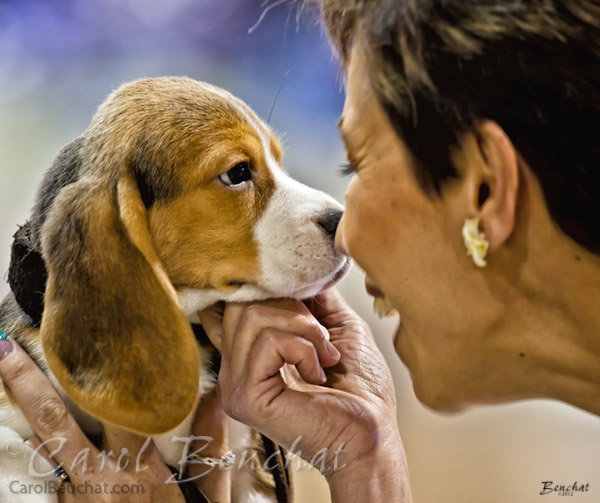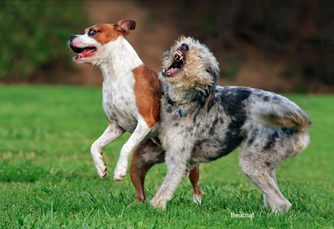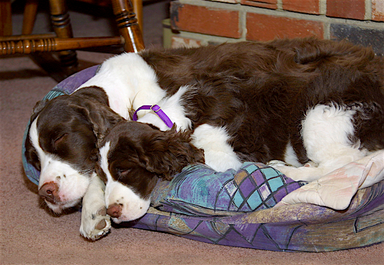|
How did the wolf, which has no special affection for humans, become our partner in work and life? The thing that sets dogs apart from any other animal is their remarkable ability to get along with people. In many ways they seem so like us, and in their boundless capacity for unconditional love and forgiveness they are often the person we wish we could be.
Dogs are the way they are because we have selected for the specific behavioral traits that make them useful to us as working dogs, protection, and companions. In some cases, we have modified innate behaviors such as the prey drive to produce a dog that stalks but does not attack, or attacks but does not kill. This was accomplished over thousands of generations, not in tightly structured breeding programs, but by breeding the dogs that got the job done and culling the ones that didn't.
|
There is much misunderstanding about the meaning of heritability and, although heritability plays a key role in selection programs in other domestic animals, it has not been widely used by the dog fancy. This is unfortunate, because a breeder that understands heritability can substantially improve the efficiency of selection in their breeding program, not just for behavior but for any trait that is affected by both genetics and environment (e.g, hip dysplasia, obesity).
So, what is heritability?
Here is a formal definition of heritability:
Heritability is the fraction of the variation in phenotype of a trait that is accounted for by the variation in genotype.
Phenotype is simply the expression of a trait, whether it be behavior, anatomy, function, or whatever. Genotype is the genetic makeup of the animal. So for example, if we are talking about the heritability of aggression in dogs, we are addressing how much of the variation in aggression from dog to dog can be attributed to variations among them in genotype.
|
By extension, the variation in the trait that is not accounted for by differences in genes is a consequence of non-genetic factors, which we collectively refer to as "environment". Environment includes not just things like temperature and physical environment, but also things like food, sound, exercise, toys - pretty much everything else you can think of that is not genetic.
The key words here are phenotype, genotype, environment, and variation. Note that we cannot discuss the variation in a trait if we are considering just a single animal. |
I'm sure you have heard this one. Look back at the definition of heritability that we stated above:
"Heritability is the fraction of the variation in phenotype of a trait that is accounted for by variation in genotype.
Heritability is about the variation in a trait from animal to animal, not the expression of the trait itself. If the heritability of a trait is 0.25 (or we can say 25%), that means that 25% of the variation in the trait in a group of animals can be attributed to variation in their genes. By extension, we can also say that 75% of the variation in our group of animals is the result of variation in environment - factors other than genetics.
Again, go back to our definition of heritability. A low heritability means that only a small amount of the variation in a trait in a group of individuals is a result of variation in their genes. If heritability is greater than 0, then genes do have some effect on the expression of the trait. It might be small, but at least some of the variation is due to genes.
But here's something tricky: a heritability of zero could either be because a trait is not affected by genes at all (e.g., the color of the shirt you're wearing today), or there is no variation in the trait and therefore none in the genes involved. For instance, the vast majority of people have five fingers on each hand. Having five fingers is definitely genetic, but the heritability of "number of fingers" is zero because there is no variation in either the trait or in the genes for the trait. And of course, you don't have a gene for "red shirt on Tuesday", although your choice might reflect the fact that red is especially attractive to you when you're stressed (genes), and you happened to have a red shirt (environment).
Likewise, if there are no environmental effects on the expression of a trait that varies among individuals, then the heritability will be equal to one: all of the variation in the phenotype of the trait can be accounted for by variations in the genes in each individual.
This is a key point: Heritability is not a fixed number for a trait. It reflects the relative contribution of genetics to the variation in a trait. If the variation in the trait is high because of variation in environmental factors, then the heritability in that population at that time will be low.
How important is it for breeders to understand all this nonsense about heritability? Very, and I'll tell you why.
Improving (or removing) a trait involves selecting those individuals that have the genes for the trait you want (or don't). Since we usually have no idea what the genes are that are involved in complex traits, we make selections based on phenotype - the expression of that trait. We assume that dogs that have the trait we want also have the genes we want and will pass them to their offspring. But is this assumption true? Maybe not.
But if heritability of a trait in a population is low, then the phenotype of the trait will not be a good reflection of genotype. A dog with high levels of aggression might have the genes for low aggression, but poor socialization or some bad experiences early in life have had a large, negative effect on the expression of that trait. That is, a dog with good genes can display a bad phenotype.
But you are only using phenotype to select the best breeding candidates; you don't know what genes they have. You are counting on your ability to pick the dogs with the genes you want based on your assessment of phenotype. If variation in phenotype doesn't accurately reflect differences in genotype, you won't be very good at identifying the best dogs to use (or not) in your breeding program.
If you're a dog breeder, this is clearly a problem. If heritability is low, phenotype is not telling you what you need to know about genotype. What can you do about this?
The simplest thing to do is evaluate additional animals that have similar genotypes, such as parents, siblings, and offspring. If related dogs don't have the temperament you want, it is unlikely that they have the genes you want either. Similarly, if good temperaments are common among related dogs, then a dog is likely to have good genes even though the expression of the trait in that dog isn't as good as you would like.
This isn't an argument to breed dogs with bad temperaments. Rather, it's a reason to try to get the best possible assessment of the genotype of a dog by considering the phenotypes of closely related dogs as well. This is one of those "baby-and-bathwater" things. Don't toss out the important thing (the genes) because of dirty bathwater. (Perhaps you have heard of "estimated breeding values" (EBVs). This is a statistical way to get a better assessment of the genotype of a dog by including information about the trait in related dogs.)
You can see that if you want to improve traits through selective breeding, it's important for you to know the heritability of the traits you are trying to select for (or against). If heritability is high, you will do a better job of choosing the dogs with the genes you want based on their phenotype. If heritability is low, phenotype will less accurately reflect genotype, and it will be harder to determine which dogs have the genes you want.
You can improve the efficiency of selection in your breeding program by doing things that will increase heritability of the traits of interest. For example, you can assess the trait under conditions that are as similar as possible for all the candidate dogs. This will reduce the amount of variation in the trait that is due to differences in environment, and higher heritability means that phenotype will be a better predictor of genotype. Evaluate an entire litter at the same time in the same place. Test all of the candidate bomb-sniffing dogs under carefully controlled conditions. Assess herding behavior of working dogs using the same herd and under conditions that are as similar as possible. By reducing environmental effects, what you see will more accurately reflect genotype.
To learn more about the genetics of dogs, check out
ICB's online courses
***************************************
Visit our Facebook Groups
ICB Institute of Canine Biology
...the latest canine news and research
ICB Breeding for the Future
...the science of animal breeding




